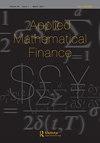期权价格隐含的风险中性跳跃到达率及其模型
Q3 Mathematics
引用次数: 1
摘要
风险中性密度的特征函数是由固定期限的期权价格构造而成的。这些特征函数的对数被用来合成跳跃到达尾的傅里叶变换。正式到达率尾部是实际到达率,如果它们的导数有适当的符号。嵌入期权价格的正式到达率尾部的衍生品有时被观察到是负的,反映了有符号跳跃的到达率。虽然一开始令人困惑,但我们进一步观察到,对称方差gamma lsamvy密度的简单解析余弦扰动提供了与概率密度一致的有符号到达率的理论例子。另外,当受独立噪声干扰的信号模型产生信号密度特征函数的例子时,也会出现带符号的到达率,这些特征函数是纯跳变无限可分特征函数的比率。这种比率特征函数可以反映签到率。具体模型使用双边伽马和CGMY模型的比率开发和校准短期期权价格。与非比率模型相比,比率模型提供了显著的改进。这些模型属于最近被称为准无限可分分布的一类。本文章由计算机程序翻译,如有差异,请以英文原文为准。
Risk Neutral Jump Arrival Rates Implied in Option Prices and Their Models
ABSTRACT Characteristic functions of risk neutral densities are constructed from the prices of options at a fixed maturity using well-known procedures. The logarithm of these characteristic functions are shown to synthesize the Fourier transform of jump arrival tails. The formal arrival rate tails are actual arrival rates if their derivatives have an appropriate sign. The derivatives of formal arrival rate tails embedded in option prices are observed on occasion to be negative, reflecting signed jump arrival rates. Although puzzling at first, we further observe that simple analytical cosine perturbations of the symmetric variance gamma Lévy density provides theoretical examples of such signed arrival rates consistent with a probability density. Additionally signed arrival rates also arise when models of signals perturbed by independent noise yield examples of characteristic functions for signal densities that are ratios of pure jump infinitely divisible characteristic functions. Such ratio characteristic functions can reflect signed arrival rates. Specific models using ratios of bilateral gamma and CGMY models are developed and calibrated to short maturity option prices. The ratio models provide significant improvements over their non-ratio counterparts. The models fall in the class of what have recently been termed to be quasi-infinitely divisible distributions.
求助全文
通过发布文献求助,成功后即可免费获取论文全文。
去求助
来源期刊

Applied Mathematical Finance
Economics, Econometrics and Finance-Finance
CiteScore
2.30
自引率
0.00%
发文量
6
期刊介绍:
The journal encourages the confident use of applied mathematics and mathematical modelling in finance. The journal publishes papers on the following: •modelling of financial and economic primitives (interest rates, asset prices etc); •modelling market behaviour; •modelling market imperfections; •pricing of financial derivative securities; •hedging strategies; •numerical methods; •financial engineering.
 求助内容:
求助内容: 应助结果提醒方式:
应助结果提醒方式:


